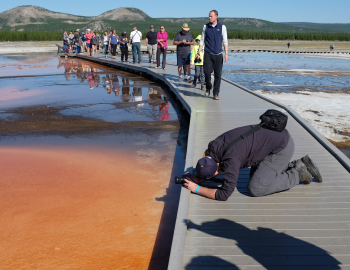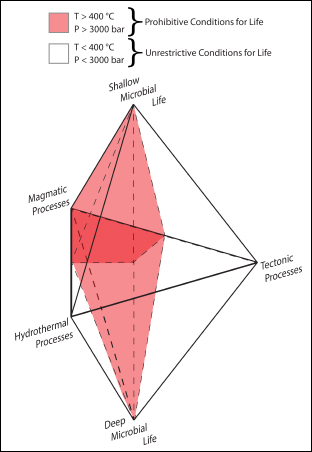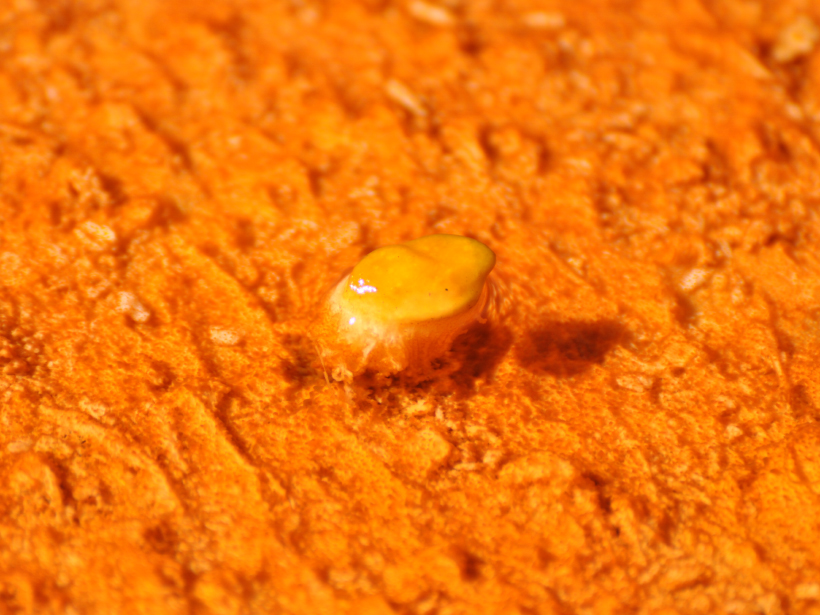Yellowstone National Park is a fascinating natural laboratory for geoscientists and biologists alike. Its steaming geysers and hot springs have been extensively studied to characterize the underlying hydrothermal activity. Scientists have also focused on microbial mat populations in extreme and hostile ecological niches with temperatures near boiling and pH from less than 1 to greater than 9. Yet little is known about the source of Yellowstone’s highly variable carbon fluxes.
Little is known about the source of Yellowstone’s highly variable carbon fluxes.
With this in mind, 38 early-career geologists, geochemists, microbiologists, and informaticians from 16 countries ventured to Yellowstone National Park for the Second Deep Carbon Observatory (DCO) Summer School in July 2016. Their goal was to study the complex interplay between the geosphere and biosphere, the effect of this interplay on the carbon-containing gases emitted by the Yellowstone volcanic system, and influences of high- and low-temperature fluids on microbial habitability through time and space.

The DCO Yellowstone short course consisted of three components:
Fieldwork: Participants studied rock unit relationships, microbial mat communities, and hydrothermal fluid chemistry, and they made in situ carbon dioxide flux measurements.
Classroom: Experts lectured and led discussions on the deep carbon cycle, extreme microbial systems, mineral evolution, the origin of life, geochemistry of gas fluxes, and fluid-rock interactions.
Science presentations: Students presented their current research as fast-paced 1-minute lightning talks, followed by a poster session. Student abstracts can be found on the DCO website.
Interdisciplinary and integrative science is essential to understanding complex systems: the ecology of extreme environments, intracontinental volcanism, and the deep carbon cycle. Participants faced the challenge of reconciling differences not only in subject matter but in temporal and spatial scales across their widely varying scientific domains. By the end of the session, DCO Summer School participants had integrated differing concepts of time and depth, fields of study, and technical experience to examine Yellowstone’s tectonic, magmatic, hydrothermal, and microbial processes and their controls on carbon dioxide flux.

Using published data and measurements acquired in the field, DCO Summer School scientists conducted a study on the conditions suitable for microbial life on Earth during the short course. The understanding they gained about the regimes in which life can interact with geologic materials and processes will enable these researchers to deepen their scientific studies and recognize fruitful cross-disciplinary collaborations.
The DCO Summer School participants are continuing to build on the work they began in Yellowstone by asking questions that address long-standing unknowns in the scientific community. Such questions include the following: What are the sources and timing of the accumulation of Earth’s volatiles in Yellowstone? What are the geochemical and geophysical contexts of organic compound synthesis that predated the emergence of life? How deep is life found in the Earth’s interior? What are the fluid flux conditions that sustain life, as well as the hydrosphere and atmosphere, on Earth?
The DCO is an interconnected community, and Summer School participants provide research updates at annual meetings, on the DCO website, and to various DCO committees. The authors thank the DCO Summer School organizers, instructors, and fellow participants as well as the DCO, American Geosciences Institute, the Center for Dark Energy Biosphere Investigations, Nano-Tech, and MO BIO Laboratories for their support.

—Shaunna M. Morrison (email: [email protected]), Geophysical Laboratory, Carnegie Institution for Science, Washington, D. C.; Mattia Pistone, Institute of Earth Sciences, University of Lausanne, Switzerland; and Lukas Kohl, Department of Chemical Engineering, University of Toronto, ON, Canada
Citation:
Morrison, S. M.,Pistone, M., and Kohl, L. (2017), Studying Yellowstone by integrating deep carbon science, Eos, 98, https://doi.org/10.1029/2017EO076209. Published on 23 June 2017.
Text © 2017. The authors. CC BY-NC-ND 3.0
Except where otherwise noted, images are subject to copyright. Any reuse without express permission from the copyright owner is prohibited.

